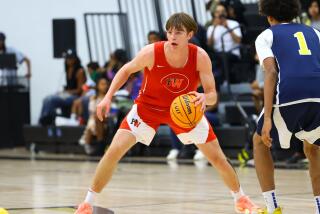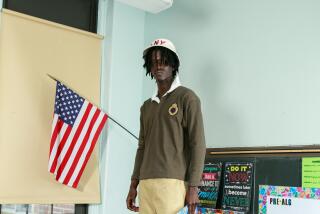High school is more than their love; it’s become their vocation
ZERO period at Palmdale High School begins at 6:30 a.m., an hour before the regular school day. It is optional, and for much of the year, students who have chosen this particular form of self-punishment arrive in near darkness, with hesitant strips of pink cloud beginning to glow in a cobalt sky.
So it is slightly surprising to walk into Steve Wilson’s class at 6:35 a.m. and find 32 students not only present and awake but also barely able to contain their enthusiasm over the start of another school day.
“Once you come to the class and you know what you’re going to be doing, you want to get up in the morning,” said Rosa Bermeo, a bright-eyed 11th-grader with wavy brown hair who is dressed, as are most of her classmates, in a yellow sports shirt stamped with the class logo.
The class is sports medicine, and it is offered by Palmdale’s Health Careers Academy, a 15-year-old school-within-a-school that has become a model of what a successful career education program can be. Students in the academy learn such real-world skills as giving injections and reading X-rays and also take college-prep math, English and science with a medical focus.
In Wilson’s class, students don’t learn just from textbooks. They practice clinical techniques, often using student athletes who limp in with various minor strains, pulls and bruises.
This morning, in a back room, juniors Veronica Buenrostro and Mirtha Ramirez are icing and massaging soccer player Davey Ramos’ sore knees.
“Ow!” Davey says, wincing as ice meets flesh.
The academy isn’t for everybody, and some students wash out by their junior year. But those who stick it out seem to share a joy in learning that often eludes their peers.
“It makes you want to be better,” Rosa said. “It makes you want to strive to be the best you can be.”
YOU don’t always hear talk like that in big public high schools like Palmdale, which serves a largely poor, predominantly Latino student body on a low-slung campus in the Antelope Valley. That is why programs like this are being watched in education circles and being copied by school districts all over the country.
Once, this sort of learning had a different name: vocational education. But by the 1990s, it had been largely discredited for selecting students by race and class and discouraging them from higher education.
Today, under new names -- career technical education, multiple pathways -- it is one of the nation’s hottest educational trends, part of the movement toward small learning communities focused on particular subjects.
There are now high school programs in California focusing on film production, finance, technology, agriculture, construction, culinary arts, law and public safety, performing arts and auto repair, among other career paths.
What sets the new programs apart from old-fashioned vocational education is an insistence on rigorous academic content that will prepare students for higher education.
“We want to help all students get to the same destination, and that is graduating from high school prepared and inspired to go on to both college and career -- not one or the other,” said Gary Hoachlander, president of ConnectEd, a nonprofit organization founded last year by the James Irvine Foundation to encourage career education in California.
There are those, including state Sen. Mark Wyland, who disagree with this approach and believe in something closer to old-fashioned vocational education.
“We as a society do not sufficiently respect people who have interests in doing things that are not academic,” said Wyland, a Republican from Escondido, who has made career education a focus of his political career.
The new wave of vocational education has a host of prominent boosters, however, including unions, business groups and Gov. Arnold Schwarzenegger, the product of an Austrian high school that trained students for jobs in retail sales. Their hope is that career-oriented education can help keep potential dropouts in school by motivating students who might otherwise see little link between classwork and the real world.
Research suggests that any effect on the dropout rate is likely to be minor. “The more rigorous studies suggest there is no effect,” the National Assessment of Vocational Education reported in 2004. But there is strong evidence that students who attend career-oriented high schools wind up earning more money when they enter the workforce. And it seems hard to deny that, at the least, the best career programs provide exciting alternatives to the standard academic path.
“The whole idea is, if you put something through their hands, they remember it a whole lot better than if you just tell them about it,” said Mike Hanlon, who co-founded the Health Careers Academy at Palmdale High with his wife, Sandy, a former respiratory therapist. Both are planning to retire at the end of this school year.
Together, the Hanlons breathed life into the academy with impassioned, tireless leadership -- the one element that is most difficult to reproduce. They somehow kept the program on track through 10 principals and probably as many shifts in educational philosophy.
Initially, “we were accused of watering down the curriculum,” Sandy Hanlon said. “It wasn’t academic-sounding enough.”
But, she said, “medicine is about as academic as you can get.”
Students in the academy don’t take English; they take medical English, with a reading list that is sprinkled with such work as “The First Appendectomy,” a magazine article by Dr. William A. Nolen, and “Surgeons must be very careful,” a poem by Emily Dickinson.
They don’t take history; they take medical U.S. history or medical world history, both of which are Advanced Placement courses. On a recent day, U.S. history teacher Matt Tassinari was teaching about the development of the polio vaccine, while world history teacher Mike Heller had built a lesson around the 1918 influenza pandemic.
The students also take such specialized courses as kinesiology, forensic biology and introduction to health careers. The early morning sports medicine class is a for-credit elective.
TODAY, the 430 academy students are among the academic stars at Palmdale, a school of 3,200 that has struggled with low standardized test scores and a high dropout rate.
Angela Hefter, who will be taking over as co-director of the Health Careers Academy next year, ticked off its statistics: A 98% pass rate the first time students take the California High School Exit Exam -- about double the rate for the school as a whole. Ninety-five percent attendance. And, most impressive, Hefter said, “We have 100% of our students graduating and going to college.”
That figure is not quite as impressive as it sounds. Although the Health Careers Academy is open to all interested ninth-graders, by 11th grade it starts weeding out students who can’t maintain a C average or whose attendance is poor. And, inevitably, there are students who decide they don’t like medicine.
By senior year, a class of 120 freshmen has been whittled down to about 50 or 65 students. It is from this pool that the academy derives its impressive dropout rate of zero. The others return to the regular school, and there has been no attempt to determine how many graduate or how, as a group, they perform.
In their junior year, academy students spend part of every day “job shadowing” medical professionals in local clinics and hospitals. In their senior year, each is assigned an internship in one of about 70 local medical establishments. Their mentors in these programs typically rave about the students. It’s easy to understand why.
Kalynn Dean, a 17-year-old senior, was leaving school one day recently when she saw a student lying on the ground. “I asked what was going on, and security said he’d had a seizure.” She knew what to do: Keep him calm, keep him from hurting himself, establish whether he could communicate.
When paramedics arrived, “I told them how long I’d been there, that he’d already aspirated and that he was unresponsive.”
Sandy Hanlon later spoke to the paramedic crew. “As far as they were concerned,” Hanlon said, “she saved this kid’s life.”
Wendi Routhier, a self-possessed senior who wants to go into sports medicine, is interning with a local chiropractor, Daniel Massari, who has taken academy interns every year for the last decade and wound up hiring “virtually all of them” as part-time assistants until they went to college.
“They are,” he said, “the kind of kids you hope your kids could become.”
Wendi said she has dropped non-academy friends who seem interested only in partying and hanging out. In the academy, she said, “we’re more -- I don’t want to say mature -- but more focused about what we want to do with our lives.”
This is a common theme among academy students, most of whom can be expected to wind up in medical careers -- as nurses, doctors, veterinarians, physical therapists and radiologists, among other jobs.
Delita Washington applied to the academy after caring for her dying grandfather. A shy girl, she has taken on a quiet self-confidence through work as an intern at an obstetrics and gynecology clinic, where she does urinalysis, draws blood, takes vital signs and administers pregnancy tests.
Through her internship, her schoolwork has taken on new meaning. Two years of Spanish classes had given her a limited ability to communicate, but her work with Spanish-speaking patients has required her to raise her ability. Now she considers learning to speak Spanish her greatest accomplishment.
Delita, now a 17-year-old senior, has remained friends with students outside the academy, but can see that her attitude toward school -- and life -- is different.
“I was told by one student that the academy was for smart students,” she said. “And I had to explain that it’s not about being smart. It’s about applying yourself and working hard.
“It’s kind of not only changed my perspective about school, but about life,” she said. “Life is a challenge, and nothing comes easy.”
*
mitchell.landsberg@latimes.com
More to Read
Sign up for Essential California
The most important California stories and recommendations in your inbox every morning.
You may occasionally receive promotional content from the Los Angeles Times.










